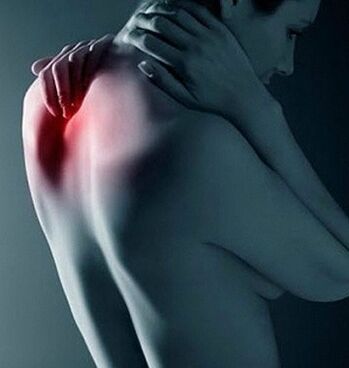Cervical osteocartilage degeneration is considered a fairly common disease that can lead to prevalence changes in the intervertebral disc.In almost 30% of the cases, the disease becomes the culprit for severe headaches.The first sign of the disease may occur at ages 25-40.Osteocartilage degeneration in the cervical spine can cause severe metabolic disorders.At the same time, the disc will lose its elasticity and its strength will be greatly reduced.The danger of this disease is that changes occurring in the spine become irreversible.Over time, the disease can spread to other departments, causing serious problems to develop, such as causing restricted physical activity, disability.
Symptoms (marks)
This disease has not caused serious discomfort for a long time.One might not guess that he is already developing osteochondrosis, because his first sign is similar to the symptoms of many other diseases.For those who experience it regularly, it is necessary to consider this disease:
- numbness in the shoulders and arms;
- Neck pain;
- The heavy shoulders.
Another common sign of the disease is the characteristic tightening around the neck and the sharp turn of the head.This indicates that the disc has begun to change.In the future, osteochondral cervical vertebrae will cause the following symptoms:
- Severe pain on the neck, back of the head;
- Dizziness;
- Numbness of fingers on hands, tingling sensation;
- Pain under the shoulder blade bone when tilting forward on the head;
- Noise in the ears.
Signs of the disease also include severe fatigue and hearing worsening.It is difficult for a person to concentrate because the pain is accompanied by him both day and night.In this regard, sleep quality deteriorates and insomnia occurs.In the later stages of development, osteocartilage of the cervical spine causes oily symptoms associated with bone growth.In this case, connect the vertebrae and fix it.As a result, a person can no longer move his neck freely, resulting in disability.
Causes of the disease
Earlier, osteochondrosis was considered to be age-related, that is, only the elderly suffered. Today, the disease is rapidly “young”.Recently, the number of patients with cervical osteochondral disease has increased significantly, ranging in age from 18 to 30 years.The disease can develop for a variety of reasons.However, most of the time it seems to be due to:
Today, the disease is rapidly “young”.Recently, the number of patients with cervical osteochondral disease has increased significantly, ranging in age from 18 to 30 years.The disease can develop for a variety of reasons.However, most of the time it seems to be due to:
- spinal curvature;
- Too much weight;
- Flat feet
- Trauma damage to the back;
- Violating metabolic processes;
- A sedentary lifestyle;
- infectious disease;
- Heavy physical labor.
In addition, the disease develops due to hereditary tendencies and the background of intense stress and emotional over-weaving.Promotes the emergence of osteochondrosis in wrong postures.A pillow that is too tall or very soft can cause clamping of the nerve ends of the neck.
The significant increase in the number of patients with osteochondrosis is also due to the usual lifestyle of modern people.For example, hypoemia and ongoing work on computers contribute to the emergence of this disease.Triggerable nutrients can lead to a lack of trace elements and vitamins in the body, which also causes the development of the disease.
Which doctor treats osteochondrosis in the cervical vertebrae?
If you seek medical help in a timely manner, you can get rid of the disease completely.Signs of cervical osteocartilage degeneration should be the basis for immediate examination.People with severe headaches need to consult a doctor like this:
- Neurologist
- Spinal supraologist
If the disease is in an advanced stage of development, a person may also have to seek help from the surgeon.On the first appointment, the doctor will definitely check the patient and listen to all his complaints.The doctor will also ask several clarification questions:

- How long does the pain occur?
- Does a person suffer from this disease?
- Did he suffer a cervical spine injury?
- Did you faint?
- What has a person become sick recently?
- Does he suffer from chronic diseases?
- Are there any other symptoms?
Doctors will use the information received from the patient to develop a single treatment plan.However, it has the right to confirm the diagnosis only after thoroughly studying the results of the hardware program.Patients will have to perform radiographs, calculations or magnetic resonance tomography.He can also perform some double-strand scans to help experts evaluate the condition of the blood vessels in the neck.
What if you don't treat your illness?
Begin treatment earlier, faster and easier to deal with the disease.Osteochondrosis in the cervical area first leads to insignificant symptoms that tend to confuse overwork.However, as the disease progresses, they become more intense and painful.Patients who do not want to treat osteochondrosis are at risk of health, as the disease can even lead to death.
Don't try to deal with this disease yourself.Such actions often lead to aggravation of the situation and rapidly develop the disease.Only qualified doctors can help get rid of the disease without consequences and only after careful and comprehensive examination of the patient.The first sign of cervical osteocartilage degeneration should change the way one normally lives.In the early stages of development, you can get rid of this disease:
- Perform regular practice;
- Switch to proper nutrition;
- Avoid over-treatment of stress and tension.
Consequences of osteochondrosis in the cervical area
Rejecting treatment, a person risked serious complications.In the cervical area, there are many neural channels and blood vessels that are fed to the brain.Their compression or displacement can cause the following problems:
- Intervertebral protrusion;
- migraine;
- hypertension;
- Vegetation dystonia.
Over time, the brain circulatory system in the work of the cardiovascular and respiratory systems has caused obstacles.A person develops problems in coordination, hearing and vision.Osteochondrosis in the advanced cervical area is a serious danger to the patient's life.Diseases can lead to brain ischemia, radiculopathy and spinal stroke.If you do not postpone the onset of treatment, you can avoid serious consequences of this disease.
Folk Methods
The treatment of the disease should be complicated.It involves taking medications, performing various procedures, and using natural remedies.If a person is diagnosed with osteochondrosis in the cervical vertebrae area, traditional medicine will help relieve symptoms and improve general conditions.Your doctor will tell you what prescriptions are effective for your patients.In most cases, the following folk remedies are used for osteochondrosis:
horseradish
The leaves of the plant must be lowered into boiling water.They were not removed and the water was allowed to cool.Then at night, the sheets are fixed around the neck and wrapped in a scarf.
lemon
Citrus must be wrapped in the meat.Add crushed garlic to the mass produced.Pour the mixture into boiling water and then brew.I eat products before meals every morning, only half a cup.Shake before use.
Brusnika leaves
They need to prepare decoctions.To do this, pour 2 teaspoons of leaves in boiling water for 15 minutes.Cool the product.Filter and drink a drink every day.
sea salt
Dissolve a tablespoon of salt in a liter of water.The mixture is boiled and then cooled.Wet the towel in this water and wipe your neck.
Chamomile and St. John's Wort
Two tablespoons of herbs must be poured with boiling water.Give the product a day to brew.Filter and drink soup every day.


























